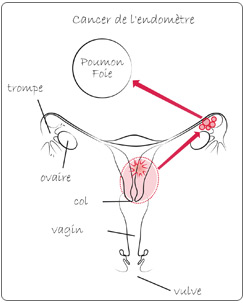Endometrial cancer
Definition

Endometrial cancer is a malignant tumor, i.e. a group of your own cells who lost ability to repair themself or to die, and will then grow uncontrollably, invading nearby parts of the body.
Endometrial cancer is one of the most common pelvic cancers, with around 6.300 new cases every year in France. Targeted women are post-menopausal around 70. When detected at an early stage, prognostic is usually good.
Major factor risks are obesity, diabetes, Tamoxifene therapy (usually used for breast cancer treatment) and inherited diseases.
Development
Endometrial cancer begins in the lining of the uterus (endometrium). Cancerous cells will grow, carrying along blood loss. Endometrial cancer will then develops on the uterine wall (myometrium), then spread outside the uterus to invade nearby organs (fallopian tubes, ovaries, bladder, rectum). Abnormal cells can migrate to pelvic glands surrounding uterus.
At a very developed stage, malignant cells can migrate far from the main tumor, and congregate in lungs or abdomen: those cells are called metastases (i.e. metastatic stage of endometrial cancer)
Endometrial cancer development stages:
Stage I : Tumor localized in the uterus.
Stage II : Tumor invading the cervix.
Stage III : Tumor invading vagina, fallopian tubes, ovaries, pelvic nodes.
Stage IV : Tumor invading vagina, fallopian tubes, ovaries, pelvic nodes.
Diagnosis
Vaginal bleeding on post-menopausal women is one of the main signs of endometrial cancer. Thin white or clear vaginal discharge in postmenopausal women – mainly due to infection – can also be an element of diagnosis. Non-menopausal women blood losses are usually related to a non-cancerous pathology.
Endometrial diagnosis will be realized by endometrium biopsy (performed at your Ob/Gyn office). If endometrium biopsy does not yield sufficient diagnosis, the Ob/Gyn will perform hysteroscopy, allowing direct visualization of the uterine cavity and permitting the doctor to obtain cell samples. MRI (Magnetic Resonance Imagery) will state on the size of the tumor, further to the diagnosis.
Treatment
Main treatment is surgical, and consists by the complete remove of uterus and cervix, fallopian tubes and ovaries (total hysterectomy with bilateral adnexectomy), as well as per-uterine lymph nodes.
Procedure used for this surgery is laparoscopy, but laparotomy may be required (for any anatomic specific conditions).
A 3 days hospital stay is needed, and a 3 weeks work leave must be planned.
According to the tumor characteristics, a multidisciplinary staff will decide dedicated supplementary treatment. Radiotherapy or brachytherapy (radiotherapy where the radiation source is placed inside the vagina) are the most common complement treatment; chemotherapy may be required.
Medical control
Meeting the doctors involved in your treatment is required every 4 to 6 months, during 3 years, then on an annual basis.
Endometrial cancer prognostic is very good, as it grows slowly, usually detected before spreading very far, and easily treated with surgery.
Last update: 10/2/2013
